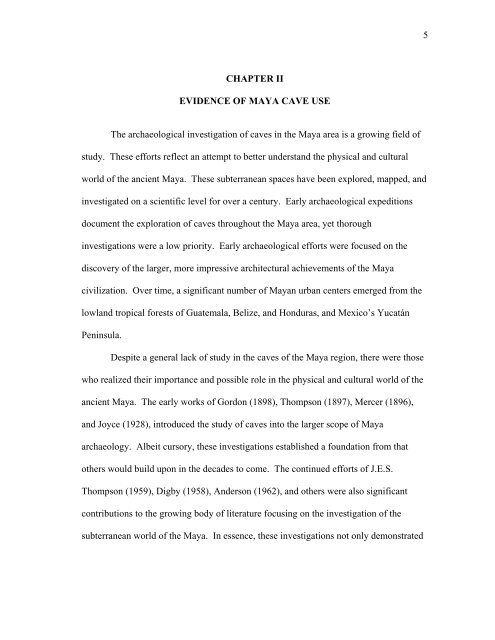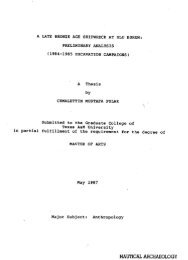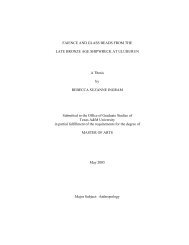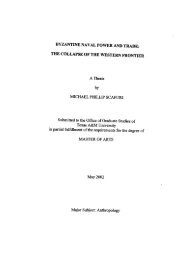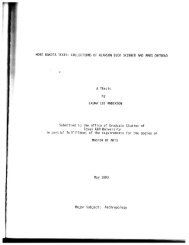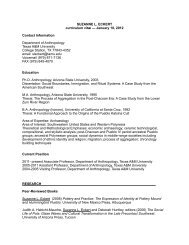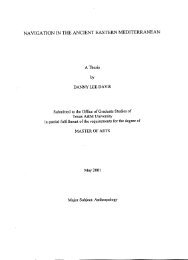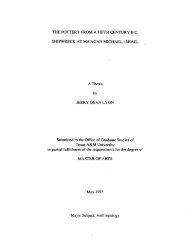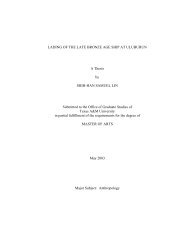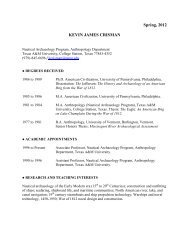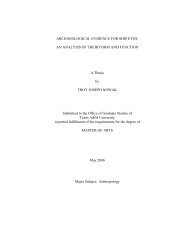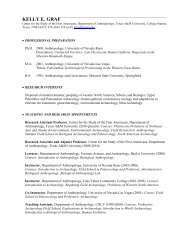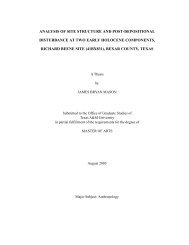- Page 1 and 2: HUMAN SKELETAL REMAINS OF THE ANCIE
- Page 3 and 4: iiiABSTRACTHuman Skeletal Remains o
- Page 5 and 6: vACKNOWLEDGEMENTSThis research was
- Page 7 and 8: viiCHAPTERPageIV SITE DESCRIPTIONS
- Page 9 and 10: ixLIST OF FIGURESFIGUREPage1 Map of
- Page 11 and 12: xiLIST OF TABLESTABLEPage1 Caves of
- Page 13 and 14: 2Fig. 1. Map of the Petexbatun regi
- Page 15: 4prove or disprove my hypothesis. T
- Page 20 and 21: 9General characteristics of Maya ca
- Page 22 and 23: 11Tlaloc and vessels with “bands
- Page 24 and 25: 13crude stone walls, simple altars,
- Page 26 and 27: 15Naj TunichThe extensive cave syst
- Page 28 and 29: 17better understanding the vast cav
- Page 30 and 31: 19or deposition of human remains wi
- Page 32 and 33: 21ancestor veneration. For example,
- Page 34 and 35: 23sample, I aim to establish the pr
- Page 36 and 37: 25The sample from the six caves of
- Page 38 and 39: 27sex assessments difficult for a l
- Page 40 and 41: 29important element in the estimati
- Page 42 and 43: 31Unlike the NISPs, the MNI estimat
- Page 44 and 45: 33modification. Photographs and mic
- Page 46 and 47: 35interment. There is evidence that
- Page 48 and 49: 37victims (Pagden 1975) manifests i
- Page 50 and 51: 39CHAPTER IVSITE DESCRIPTIONSThe ar
- Page 52 and 53: Fig. 4. Map of Cueva de El Duende.
- Page 54 and 55: 431991:680). A few human remains we
- Page 56 and 57: Fig. 5. Map of Cueva de Río El Due
- Page 58 and 59: 47including three additional cave e
- Page 60 and 61: 49hollow. According to Brady (1990b
- Page 62 and 63: 51resumed during the 1993 field sea
- Page 64 and 65: 53CQ. This is the only cave not con
- Page 66 and 67:
55deflocculent technique used in tw
- Page 68 and 69:
57TABLE 2. Number of identified spe
- Page 70 and 71:
59skeletal elementpedal phalangemet
- Page 72 and 73:
61TABLE 3. MNI for Cueva de El Duen
- Page 74 and 75:
63in Guatemala (Wright’s unpublis
- Page 76 and 77:
65construction, the movement of mat
- Page 78 and 79:
67CNP2-28-1TABLE 4. continued.Lot #
- Page 80 and 81:
69TABLE 5. PNI for Cueva de Río El
- Page 82 and 83:
71pedal phalangemetatarsaltarsalcal
- Page 84 and 85:
73TABLE 6. MNI for Cueva de Río Mu
- Page 86 and 87:
75skeletal elementhyoidmaxillazygom
- Page 88 and 89:
77material, most of which consists
- Page 90 and 91:
79TABLE 7. continued.CS9-06-1CS11-0
- Page 92 and 93:
81TABLE 8. PNI for Cueva de Sangre.
- Page 94 and 95:
83Cueva de Kaxon Pec. These do not
- Page 96 and 97:
85TABLE 9. MNI for Cueva de Kaxon P
- Page 98 and 99:
87TABLE 10. PNI for Cueva de Kaxon
- Page 100 and 101:
89skeletal elementcalcaneustalustib
- Page 102 and 103:
91adults of indeterminate age and s
- Page 104 and 105:
93CHAPTER VIBONE MODIFICATIONBone m
- Page 106 and 107:
95deposition of the individual(s) i
- Page 108 and 109:
97tuberosity indicates an individua
- Page 110 and 111:
99CQ1-16-8/2This left femur has cle
- Page 112 and 113:
101are shorter in length (7.9 mm ea
- Page 114 and 115:
103possible cut marks, but determin
- Page 116 and 117:
105CNP2-26-1/3Several vertical mark
- Page 118 and 119:
107CHAPTER VIIDISCUSSION AND INTERP
- Page 120 and 121:
109archaeological record. Thus, it
- Page 122 and 123:
111which may resemble a particular
- Page 124 and 125:
113sex (including several males and
- Page 126 and 127:
115subterranean contexts. Moreover,
- Page 128 and 129:
117that suggest post-mortem activit
- Page 130 and 131:
119Cueva de Kaxon PecCKP is the las
- Page 132 and 133:
121sample demonstrate that several
- Page 134 and 135:
123The Maya regarded the cave as a
- Page 136 and 137:
125worldview. Despite the subterran
- Page 138 and 139:
127Brady JE. 1995. A Reassessment o
- Page 140 and 141:
129Colas PR, Reeder P, Webster J 20
- Page 142 and 143:
131Massey VK, DG Steele. 1997. A Ma
- Page 144 and 145:
133Tedlock D. 1985. Popol Vuh: The
- Page 146 and 147:
APPENDIX135
- Page 148 and 149:
CD2-01-4 maxilla L portion w/ alveo
- Page 150 and 151:
CD4-00-1 hamate R completeCD4-00-1
- Page 152 and 153:
CNP2-04-1/5 femur L prox.2/3 shaft,
- Page 154 and 155:
CNP2-10-1/2 femur R complete shaft
- Page 156 and 157:
CNP2-16-1 femur R shaft, surface er
- Page 158 and 159:
CNP2-24-1/1 mandible L complete bod
- Page 160 and 161:
CNP2-28-1 lower m2 L complete crown
- Page 162 and 163:
CNP2-30-1/5 parietal L-R large frag
- Page 164 and 165:
CRM3-01-2 pelvis ? small portion of
- Page 166 and 167:
APPENDIX IVINVENTORY FOR CUEVA DE S
- Page 168 and 169:
CS2-10-1 upper p3 L nearly complete
- Page 170 and 171:
CS5-01-1/2 femur R prox.1/2 shaft,
- Page 172 and 173:
CS5-10-1 radius R dist.2/3 shaft, n
- Page 174 and 175:
CS9-03-1 B19/2 pariet/frontal both
- Page 176 and 177:
CS9-05-1/3 vertebra A cervical, com
- Page 178 and 179:
CS11-03-2B humerus R complete, head
- Page 180 and 181:
CS11-05-1 grp.A/3 calcaneus L compl
- Page 182 and 183:
APPENDIX VINVENTORY FOR CUEVA DE KA
- Page 184 and 185:
CKP2-03-1/46 vertebra A thoracic, t
- Page 186 and 187:
CKP2-08-1/15 cranial ? 8 frags, sta
- Page 188 and 189:
APPENDIX VIINVENTORY FOR CUEVA DE L
- Page 190:
179VITAAmador Minjares, Jr.221 Locu


